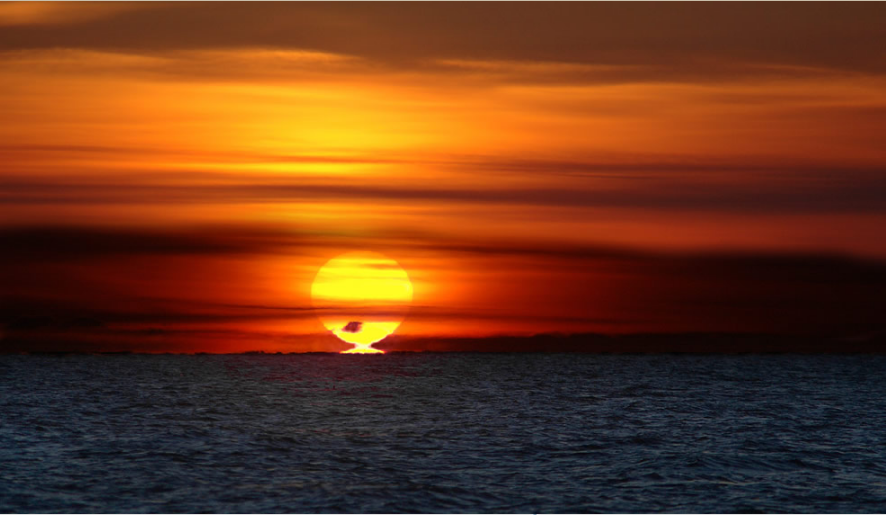Green flash over the North Sea
Green Flash over the North Sea: A Spectacular Phenomenon
Have you ever witnessed a green flash during a sunrise or sunset? This mesmerizing atmospheric phenomenon, known as a green flash, occurs when the last glimpse of the sun appears as a vivid green color for a brief moment. While this phenomenon can be observed in various locations around the world, the North Sea offers a particularly captivating backdrop for experiencing the green flash. In this article, we will delve into the details of this extraordinary event and explore the science behind it.
What Causes the Green Flash?
The green flash is a result of the Earth's atmosphere acting as a prism, separating sunlight into its component colors. As the sun approaches the horizon, its light passes through a greater thickness of the atmosphere, causing more scattering and absorption of shorter wavelengths (such as blue and green) compared to longer wavelengths (such as red and orange). This selective scattering is responsible for the vibrant hues observed during sunsets and sunrises.
Atmospheric Conditions and Refraction
To witness a green flash, specific atmospheric conditions are necessary. A stable atmosphere with minimal turbulence is essential, allowing for clear visibility. Additionally, the presence of temperature inversions, where a layer of warm air lies above a layer of colder air, plays a crucial role. This temperature gradient causes the light to refract and bend, intensifying the green color at the last moment before the sun disappears completely.
The North Sea's Unique Setting
The North Sea provides a unique setting for observing the green flash due to its vast expanse of water and relatively unobstructed horizon. With its wide open views and often dramatic cloud formations, this region offers ideal conditions for witnessing this awe-inspiring event. Whether standing on a picturesque coastal cliff or aboard a ship sailing across the sea, the North Sea presents an enchanting backdrop for experiencing the green flash phenomenon.
Capturing the Green Flash
Photographing the green flash can be challenging, as it occurs for only a fraction of a second. To increase your chances of capturing this elusive moment, it is recommended to use a fast shutter speed and a telephoto lens. Patience and careful observation are key, as the green flash may occur just as the sun disappears below the horizon. With the right equipment and a bit of luck, you may be able to immortalize this extraordinary spectacle.
Other Atmospheric Optics Phenomena
While the green flash is undoubtedly captivating, it is just one of many fascinating atmospheric optics phenomena. The atmosphere is a canvas for an array of breathtaking events, including halos, rainbows, sundogs, and mirages. These optical phenomena are caused by the interaction of light with ice crystals, water droplets, or variations in temperature and air density. Exploring these phenomena further can deepen our understanding and appreciation of the natural world around us.
The Science of Atmospheric Optics
Atmospheric optics is a branch of science that seeks to understand and explain the behavior of light in the Earth's atmosphere. By studying the interactions between sunlight and atmospheric particles, scientists can unravel the mysteries behind these captivating optical phenomena. Through advancements in technology and the use of sophisticated instruments, researchers continue to expand our knowledge and shed light on the intricacies of the atmosphere.
The Green Flash: A Phenomenon to Cherish
The green flash over the North Sea is a breathtaking spectacle that showcases the beauty and complexity of our natural world. Whether you are an avid photographer, a curious observer, or simply someone who appreciates the wonders of nature, witnessing this phenomenon can be a truly remarkable experience. So, next time you find yourself near the North Sea during a sunrise or sunset, keep your eyes peeled for the elusive green flash and prepare to be captivated by its ethereal beauty.
Conclusion
The green flash over the North Sea is a phenomenon that combines the magic of optics with the majesty of nature. Understanding the science behind this event enhances our appreciation for the intricacies of light and atmosphere. Whether you witness it firsthand or explore it through photographs and accounts, the green flash is an extraordinary phenomenon that reminds us of the wonders that await us in the world around us. So, let us cherish these fleeting moments and revel in the mysteries that lie within our atmosphere.

A classical "Omega" miraged sunrise at Hartlen Point Nova Scotia imaged by Shaun Lowe (photography) on 6th March 2005. The omega, a balloon shaped erect sun above an inverted solar image, was created by refraction between a warmer air layer over the ocean surface and higher, colder air. The spiky horizon is characteristic of miraged sunsets and sunrises. Image ©Shaun Lowe, shown with permission.
Note: this article has been automatically converted from the old site and may not appear as intended. You can find the original article here.
Reference Atmospheric Optics
If you use any of the definitions, information, or data presented on Atmospheric Optics, please copy the link or reference below to properly credit us as the reference source. Thank you!
-
<a href="https://atoptics.co.uk/blog/green-flash-over-the-north-sea-2/">Green flash over the North Sea</a>
-
"Green flash over the North Sea". Atmospheric Optics. Accessed on November 26, 2024. https://atoptics.co.uk/blog/green-flash-over-the-north-sea-2/.
-
"Green flash over the North Sea". Atmospheric Optics, https://atoptics.co.uk/blog/green-flash-over-the-north-sea-2/. Accessed 26 November, 2024
-
Green flash over the North Sea. Atmospheric Optics. Retrieved from https://atoptics.co.uk/blog/green-flash-over-the-north-sea-2/.